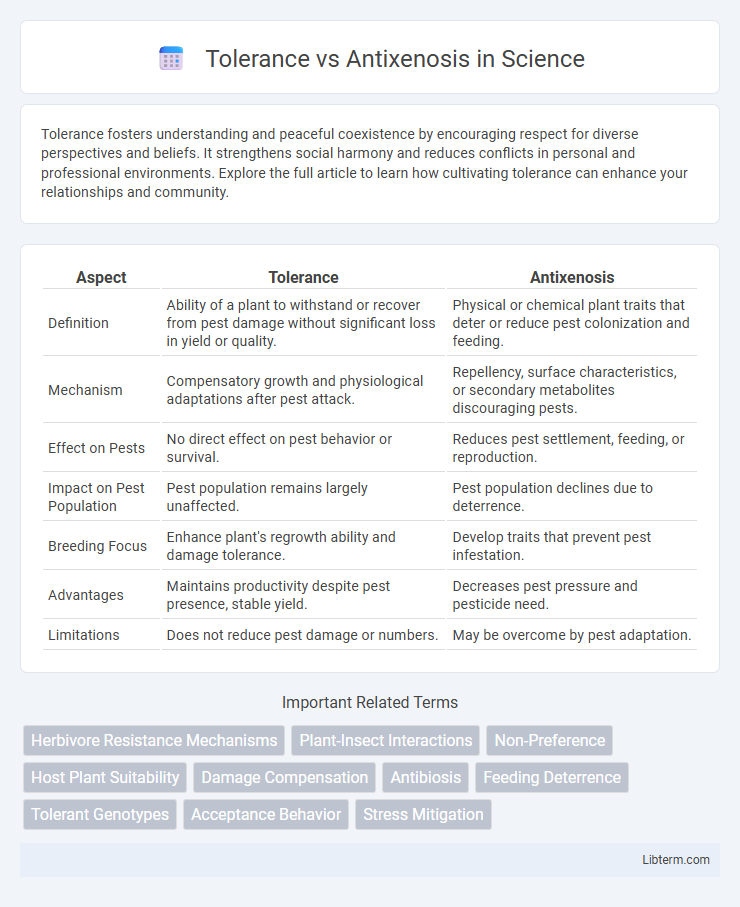Tolerance fosters understanding and peaceful coexistence by encouraging respect for diverse perspectives and beliefs. It strengthens social harmony and reduces conflicts in personal and professional environments. Explore the full article to learn how cultivating tolerance can enhance your relationships and community.
Table of Comparison
| Aspect | Tolerance | Antixenosis |
|---|---|---|
| Definition | Ability of a plant to withstand or recover from pest damage without significant loss in yield or quality. | Physical or chemical plant traits that deter or reduce pest colonization and feeding. |
| Mechanism | Compensatory growth and physiological adaptations after pest attack. | Repellency, surface characteristics, or secondary metabolites discouraging pests. |
| Effect on Pests | No direct effect on pest behavior or survival. | Reduces pest settlement, feeding, or reproduction. |
| Impact on Pest Population | Pest population remains largely unaffected. | Pest population declines due to deterrence. |
| Breeding Focus | Enhance plant's regrowth ability and damage tolerance. | Develop traits that prevent pest infestation. |
| Advantages | Maintains productivity despite pest presence, stable yield. | Decreases pest pressure and pesticide need. |
| Limitations | Does not reduce pest damage or numbers. | May be overcome by pest adaptation. |
Understanding Plant Resistance: Tolerance vs Antixenosis
Tolerance in plant resistance refers to a plant's ability to withstand or recover from pest damage without significantly reducing yield, whereas antixenosis involves mechanisms that deter pest establishment or feeding to prevent damage. Understanding the distinction is crucial for integrated pest management, as tolerance minimizes economic loss while antixenosis reduces pest populations. Effective breeding programs often combine both traits to enhance overall crop resilience against pests.
Defining Tolerance in Plant-Host Interactions
Tolerance in plant-host interactions refers to the plant's ability to endure or minimize damage caused by pests or pathogens without significantly affecting its growth or yield. Unlike antixenosis, which involves the plant's capacity to repel or discourage pest colonization, tolerance allows the plant to maintain productivity despite infestation. This defense mechanism is crucial for sustainable agriculture because it reduces the need for chemical controls while supporting crop resilience.
What is Antixenosis? Mechanisms and Benefits
Antixenosis is a plant resistance mechanism that deters herbivorous insects from feeding or ovipositing by creating an unfavorable or non-preferable environment. This resistance strategy involves traits such as physical barriers, chemical deterrents, and morphological characteristics that reduce pest attraction and colonization. The benefits of antixenosis include decreased pest damage, lower reliance on chemical pesticides, and enhanced crop yield stability through natural pest management.
Key Differences Between Tolerance and Antixenosis
Tolerance refers to a plant's ability to endure pest damage without significant yield loss, whereas antixenosis involves plant traits that deter or repel pests, preventing infestation. The key difference lies in tolerance mitigating damage post-infestation, while antixenosis functions pre-infestation by reducing pest colonization. Understanding these distinctions aids in developing integrated pest management strategies combining resistance mechanisms for sustainable crop protection.
Genetic Basis of Tolerance and Antixenosis
The genetic basis of tolerance involves complex quantitative trait loci (QTLs) that regulate a plant's ability to endure pest damage without significant yield loss, often linked to stress-responsive genes and metabolic pathways. Antixenosis, governed by specific genes controlling morphological and biochemical traits such as trichome density, leaf surface chemistry, and volatile organic compounds, deters pest colonization and feeding behavior. Both tolerance and antixenosis exhibit polygenic inheritance but differ in their genetic mechanisms: tolerance minimizes damage impact while antixenosis prevents pest establishment through genetically encoded resistance traits.
Examples of Tolerance in Major Crop Species
Tolerance in major crop species involves the plant's ability to withstand pest damage without significant yield loss, contrasting with antixenosis which deters pest colonization. Examples include wheat varieties that maintain grain production despite aphid infestations, rice strains exhibiting resilience to brown planthopper feeding, and cotton cultivars withstanding boll weevil attack while sustaining fiber quality. These tolerant crops are crucial in integrated pest management, reducing reliance on pesticides by minimizing economic damage caused by pests.
Antixenosis Traits in Pest Management Strategies
Antixenosis traits in pest management strategies involve plant characteristics that deter pest colonization or feeding, such as trichomes, surface waxes, and volatile organic compounds. These traits reduce pest attractiveness or interfere with pest behavior, effectively minimizing crop damage without relying on chemical controls. Integrating antixenosis mechanisms into breeding programs enhances sustainable pest resistance by reducing pest establishment and population growth.
Assessing the Effectiveness of Tolerance and Antixenosis
Assessing the effectiveness of tolerance involves measuring a plant's ability to withstand pest damage without significant yield loss, typically quantified through physiological parameters and yield stability under infestation. Antixenosis effectiveness is evaluated by observing pest behavior, such as reduced feeding, oviposition, or colonization preference, often through choice and no-choice tests in controlled environments. Combining tolerance and antixenosis assessments provides a comprehensive understanding of pest management potential, optimizing crop resistance strategies against specific insect pests.
Integrating Tolerance and Antixenosis in Breeding Programs
Integrating tolerance and antixenosis in breeding programs enhances crop resilience by combining traits that reduce pest damage and deter pest colonization. Breeders focus on identifying genetic markers linked to both tolerance, which allows plants to endure pest attacks with minimal yield loss, and antixenosis, which prevents pest establishment. This dual approach optimizes pest resistance, improves sustainability, and reduces reliance on chemical controls in agricultural systems.
Future Perspectives on Enhancing Plant Resistance
Future perspectives on enhancing plant resistance emphasize integrating tolerance and antixenosis mechanisms to develop durable crop protection strategies. Advances in genomic tools and CRISPR gene editing enable the identification and manipulation of specific genes responsible for tolerance to stress and antixenosis traits deterring pests. Combining high-throughput phenotyping with machine learning accelerates breeding programs targeting enhanced resistance, ensuring sustainable agricultural productivity amid evolving biotic pressures.
Tolerance Infographic

 libterm.com
libterm.com